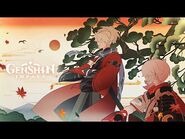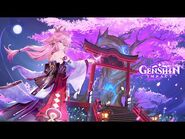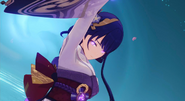Raiden Ei (Japanese: 雷電影 Raiden Ei), also known by her Goetic[Note 1] name Beelzebul and as the Raiden Shogun, is the God of Eternity and the current Electro Archon among The Seven who presides over Inazuma. She abandoned her body and transferred her consciousness into the Musou Isshin, which is now stored in the Shogun puppet.
The previous Electro Archon, Ei's older twin sister Makoto, also known as Baal, died 500 years ago in the cataclysm. Since then, Ei has assumed the Shogunate and continued to rule under the name Baal.
Since Ei cloistered herself to meditate in the Plane of Euthymia, her puppet has been in charge of Inazuman civil affairs. Since the events of Act II of the Imperatrix Umbrosa Chapter, she has decided to relinquish her original idiosyncrasies and work with the puppet, which has its own consciousness, to further Inazuma with a more forward-thinking governance.
Profile
Introduction
This body is the noblest and most eminent of all in this world.
It should hold absolute control over this world.
It once promised its people a dream: the never-changing "eternity."—Beelzebul, Vajrada Amethyst Gemstone
Makoto and Ei were twin gods who won the Archon War together. When Makoto established the Shogunate, Ei became her kagemusha (Japanese: 影武者 "shadow warrior"), or body double. As far as the world was aware, there was only one god named Baal, the Raiden Shogun of Inazuma.[8]
After Makoto's death, Ei kept herself inside the Plane of Euthymia and let her puppet, the Shogun, control the daily affairs of Inazuma.
Appearance
The Raiden Shogun uses the tall female model. She has pale skin, purple eyes with light blue pupils, and long, dark violet hair that becomes lighter at the ends, which glow when she uses her Elemental Skill or her Elemental Burst. She also has a beauty mark below her right eye.
During the Chapter II Prologue, she is depicted as a tachi-wielding woman with long violet-colored hair that was worn down. She wore a kimono which is similar to the one she wears in the present day.
Quests and Events
Archon Quests
- Chapter II
- Chapter III
- Act III: Dreams, Emptiness, Deception
- The Gaze From a Certain God (cutscene)
- Act III: Dreams, Emptiness, Deception
Story Quests
Events
- Hues of the Violet Garden
- Akitsu Kimodameshi
- Part I: Test of Courage
- Duel! The Summoners' Summit!
- Round 3: Cards Out! Grievances Begone
Story
History
Little is known about the history of the twin gods Makoto and Ei. The two gods won the Archon War together, before deciding to "split" — Makoto would serve as the actual ruler of Inazuma, while Ei served as her kagemusha, or body double. They governed Inazuma together; Ei was close friends with Sasayuri, Mikoshi Chiyo, Kitsune Saiguu, and Yae Miko. She also met Morax and Barbatos while accompanying Makoto to one of The Seven's occasional reunions in Liyue.
All those who dwelled in the nation lived in peace as long as the Shogunate's borders were not threatened. At some point after creating Watatsumi Island, the god Orobashi attacked Yashiori Island with his followers due to having been sentenced to death by Celestia for reading the book Before Sun and Moon, which recorded history that they wanted hidden, as well as paying for Enkanomiya's transgressions. Ei rallied the Shogunate forces against the god and his followers. In the ensuing war, Sasayuri was killed and Ei killed Orobashi with the Musou no Hitotachi on the island with such force that it created the Musoujin Gorge. Neither Ei nor Makoto were aware of the true motive behind Orobashi's attack.
During the cataclysm, the threat of the Abyss prompted Ei to take up arms once more alongside Makoto, Chiyo, and Saiguu. Chiyo was swallowed by a "beast of sin"; while she broke out, she was corrupted by its taint and drew her sword against Ei. In the ensuing fight, Ei sliced off Chiyo's horns and her sword-arm, but did not chase after the corrupted oni. When Ei learned that Makoto had gone to Khaenri'ah alone, she pursued her sister, tasking Saiguu with defending Inazuma. By the time she had arrived, Makoto was already dying, much to Ei's horror, although the former archon was able to preserve some of her consciousness. After returning from Khaenri'ah, Ei assumed her sister's position in both the Shogunate and a member of The Seven. She used the powers of the Sacred Sakura to eliminate all of the monsters plaguing Inazuma, bringing peace back once more, though Saiguu had died in the process. The incident left her deeply scarred from "erosion."
At some point after the cataclysm, through unknown means and with the help of Khaenri'ahn techniques, Ei created an experimental puppet as a proof of concept to see if she could "escape" erosion, who later called himself Kunikuzushi. She had wished to use him to store her Gnosis, but Kunikuzushi shed tears upon creation, causing Ei to believe him to be too gentle for the task. Taking apparent pity on him, she decided to seal his powers and leave him in a slumber in the Narukami Shrine.[1] Later, he arose from that slumber and roamed the Inazuman countryside where he would eventually be discovered by the Fatui and took on the name Scaramouche. She soon had a puppet version of herself created, making sure that it followed her ideals. Satisfied with her work, she gave her Gnosis to Miko before removing her consciousness from her body into the Musou Isshin after she made sure she had a way to get out if it was ever required.
This way, her people wouldn't be in danger of transgressing the Heavenly Principles and be punished for it, like Khaenri'ah did, and she herself would survive as their permanent god by preserving her consciousness free of erosion and keeping an indestructible artificial body, so that her people wouldn't suffer the loss she herself experienced when Makoto died.
A year before the game's current events, the Shogun puppet was deceived by the Fatui and allowed the corrupt members of the Tri-Commission, headed by Kujou Takayuki, to enact both the Vision Hunt and Sakoku Decrees with Ei's tacit approval, shuttering her nation off from the rest of Teyvat. According to Zhongli, the mortal vessel of Morax, she had ordered the Inazuma Shogunate to collect all of the Visions in the country, where they were laid into the Statue of the Omnipresent God for reasons unknown. No one, including her people, has since been granted an Electro Vision.
Present Day
During the Rite of Descension, Morax faked his death to see if Liyue could survive without him. He guessed that Ei would learn of his "death" and retirement, which would cause her to accelerate her plans. Ei, for her part, believed that his story was not over yet.
When the Traveler arrived on Inazuma to speak with Ei, they were instead roped by the resistance to help abolish the Vision Hunt Decree, first encountering her in the Plane of Euthymia when they attempted to intervene after the Shogun apprehended Thoma to take his Vision. In this encounter, she defeated them, but the Traveler managed to escape thanks to Thoma's intervention. While aiding the Watatsumi Army, they are rescued by Miko from Scaramouche, who revealed that the Electro Archon is Ei, who they encountered in the plane; the one in the real world was actually her puppet. She believed that Ei had taken an interest in them and assisted them in reaching her again for a rematch, believing that if they managed to defeat her, she would rescind the Vision Hunt Decree. The Traveler met Ei again on the steps of Tenshukaku when the Shogun attempted to attack the Watatsumi Army, who had arrived to confront her. Drawing on the powers of the seized Visions with Miko's help, they were able to convince Ei to rescind the Vision Hunt Decree, returning all the seized Visions as long as their owners could be found.
After learning of the full extent of the damage dealt to the nation, Ei immediately ordered the arrest of both the Kanjou and Tenryou Commissioners for their deception and started making changes to the Shogun's protocols to fit her new notions of Eternity. However, she had made little progress in doing so as the Shogun was never intended to be changed and that it had begun to see her as an enemy of eternity following her change of mind[9] resulting in it rebelling against her to maintain the eternity she originally sought.
Ei managed to prove that her newfound resolve wasn't a product of erosion to the Shogun in a duel. As part of a new agreement, Ei would no longer rule the nation on the basis of fear of the Heavenly Principles, honoring past sacrifices instead of trying to prevent further loss by overprotecting Inazuma from the dangers of its progress.
Though Shogun becomes her kagemusha, Ei vows not to regard her as a mere tool of eternity, just like her sister did with herself, as she began to play a more active role in Inazuma's policies while the people of the nation began to know her as an individual instead of holding onto their unrealistic notion of a permanent and omnipresent god. Both decrees were also abolished, to the delight of many.
Character Mentions
Character Stories
| Character | Stories |
|---|---|
Character Voice-Overs
| Character | Voice-Overs |
|---|---|
| |
| |
| |
| |
| |
| |
As Baal:
| |
| |
| |
| |
As Baal:
|
Trivia
- The pinnacle of Ei's swordsmanship is the Musou no Hitotachi (Japanese: 無想の一太刀 Musou no Hito-tachi, "One Slash of No Conception"), the symbol of ultimate power.[10] The sword skill is said to be only witnessed during "divine punishment."[10]
- According to the in-game archive description for Shibas, Ei was once allegedly quite fond of the dog breed.
- Several aspects regarding Makoto, Ei, and the Raiden Shogun's identities were hinted at before the Archon Quests revealed it:
- The Raiden Shogun's character teaser and character demo heavily emphasized the imagery of two Raiden Shoguns, which are meant to be Makoto and Ei.
- The English name for Vajrada Amethyst Gemstone hinted that the Raiden Shogun seen in Inazuma is a puppet. The real Ei is inside her weapon: At the time of the reveal, it was the only gemstone that did not derive its name from a Hindu god. Instead, its name comes from Vajra, the weapon wielded by Indra, the Hindu god of rain and thunder.
- Both Ei and The Shogun have recited multiple poems in the character demo and other media. (See Raiden Shogun/Lore)
Etymology
- In Shinto mythology, Raiden (Japanese: 雷電 Raiden) is another name for Raijin, the kami, or god of lightning, thunder, and storms. Raiden also means "thunder and lightning" in both Japanese and Chinese.
- "Ei" (Japanese: 影) literally means "shadow". This is an allusion to her role as a body double for her sister Makoto, as "Makoto" (Japanese: 真) literally means "real" or "true".
- Ei is loosely based on Raiden Mei, a character from Houkai Gakuen 2 and Honkai Impact 3rd, other games created by miHoYo. Raiden Mei, Makoto, and Ei are strikingly similar to each other:
- Raiden Mei, Makoto, and Ei all have purple eyes and long purple hair.
- Raiden Mei, Makoto, and Ei all harness the power of lightning (Electro).
- Raiden Mei is the 3rd Herrscher (the Herrscher of Thunder), while Baal is the third among the Seven Archons to appear.
- Honkai Impact 3rd also has an official manga titled "Escape from Nagazora." It has a chapter called "The Wrath of Baal," which showcases Mei's first appearance as the Herrscher of Thunder.
- Raiden Mei, Makoto, and Ei are all voiced by the same voice actress in Japanese, Miyuki Sawashiro (沢城 みゆき) and the same voice actress in Chinese, Juhuahua (菊花花).
- Both characters have fought an elite member of a powerful organization. Said members are also associated with Lepidoptera (butterflies/moths). The Raiden Shogun fought Signora, whose surname (Lohefalter) means "blazing butterfly," while Raiden Mei fought a simulation of Aponia. Aponia is also a genus of moths from the family Crambidae.
- Beelzebub (also spelled Beelzebul) was the name of a Philistine deity and is known in Demonology as one of the Seven Princes of Hell. Many Christian theological sources recognize the name Beelzebub as another name for Satan.
- The source for the name Beelzebub comes from the Book of Kings in the Hebrew Bible, written as בַּעַל זְבוּב Baʿal Zəvûv. As such, Ba'al was a title and honorific meaning "owner" or "lord" in antiquity.
- So far, Beelzebul is the only Archon name that does not appear in the Ars Goetia.
- Beelzebul as a shogun is most likely inspired by Tokugawa Ieyasu (1543–1616), the founder and first shogun of the Tokugawa Shogunate (1603–1868).
- The Japanese name of her constellation is 天下人座 Tenkabito-za, "Seat of the Person under the Heaven". 天下人 Tenkabito means a person who virtually holds the reins of the nation and usually refers to three powerful warlords: Oda Nobunaga, Toyotomi Hideyoshi, and Tokugawa Ieyasu, of which the last is the only 天下人 tenkabito who became a shogun.
- Although the official decree of Sakoku was issued under the reign of his grandson, there were several precursors of the Sakoku decree during Ieyasu's reign.
- Like Ei, Ieyasu was skilled in swordsmanship. He is said to have mastered the Ichi no Tachi (Japanese: 一之太刀 Slash of One) in his later years, the ultimate sword art of the Kashima Shintou school that only a chosen few were allowed to learn,[11] which may have inspired the "Hitotachi" (Japanese: 一太刀 One Slash) part of the Musou no Hitotachi (see later part for "Musou").
- Ieyasu also patronized two swordsmen and their schools: Yagyuu Munenori of the Yagyuu-Shinkage school and Ono Tadaaki of the Ittou school. The former school may have inspired the swordsman Iwakura Michihiro in the game (see the article for details). The latter school is known for the semi-legendary sword art Musouken (Japanese: 夢想剣 Sword of the Dream), which may have inspired the name of Musou Shinsetsu (Japanese: 夢想真説 True Teachings of the Dream), the Elemental Burst of the playable Raiden Shougun (but not "Musou" in the Musou no Hitotachi during the story and in past legends, which has a different kanji).
- There is a conspiracy theory that Ieyasu had a kagemusha (body double) and the kagemusha took the place of real Ieyasu at some point in the history.[12] It is not taken a serious consideration by historians but is a popular theme in Japanese historical fictions. This theory may have inspired the in-game lore that Ei was originally a kagemusha of Makoto.
- Ei as the God of Eternity is likely inspired by the shogun Tokugawa Ieyasu's faith in Pure Land Buddhism.
- Her title "Plane of Euthymia" is called "Pure Land of One Mind" (Japanese: 一心浄土 Isshin Joudo) in the East Asian versions, which refers to the realm of perfect purity and quietude in one's mind, namely a Buddhist version of idealism that all beings arise from mind and thus buddhas and their meditation realms (Pure Land) also reside in one's own mind.[13] Historically, Ieyasu was an avid follower and patron of the Pure Land School (Japanese: 浄土宗 Joudo-shuu), and he adopted the school's slogan "Abhor the Impure Land, Aspire to the Pure Land" (Japanese: 厭離穢土 欣求浄土 Enri-Edo Gongu-Joudo) as his banner sign.[14]
- Unlike other schools of Buddhism (which are generally anti-dogmatic and embrace impermanence), Pure Land Buddhism emphasizes a strong faith in Amida (Japanese: 阿弥陀), the Buddha of Infinity. The name Amida comes from the Chinese name Ēmítuó (Chinese: 阿弥陀), which in turn is the combination of two Sanskrit names: Amitābha (Sanskrit: अमिताभ) meaning "Infinite Light" and Amitāyus (Sanskrit: अमितायुस्) meaning "Infinite Longevity." Both properties of Amida match Ei's orientation to eternity (especially eternal longevity).
- After the cataclysm, Ei claimed her body was the most eminent in the world and promised never-changing eternity to her people. Similarly, Ieyasu was posthumously deified as a dai-gongen, or a great manifestation of a buddha as a Shinto god, because he claimed he wanted to be a guardian of the nation even after his mortal life ended.[15] In addition, Ieyasu's slogan "Abhor the Impure Land, Aspire to the Pure Land" is alleged to represent his determination to end the cataclysm of the Sengoku period (Warring States period) and build a pure land in this world by bringing peace.[14]
- The Statue of the Thousand-Armed, Hundred-Eyed God is most likely a reference to Senju-Kan'non (Japanese: 千手観音 "Thousand-Armed Avalokiteśvara"), a manifestation of the bodhisattva Kan'non (Japanese: 観音; Sanskrit: अवलोकितेश्वर Avalokiteśvara), one of the two main assistants of Amida.
- In her realm, Ei meditates in the sitting position of hanka fumisage (Japanese: 半跏踏下 "half-lotus pendant"), a variant of the half-lotus position (but not necessarily a foot has to be placed on a thigh). In Buddhist art in Japan, this position is commonly used to depict the bodhisattva Miroku (Japanese: 弥勒; Sanskrit: मैत्रेय Maitreya), an object of worship in Pure Land Buddhism that predates worship for Amida. Miroku is said to confine himself in his realm of Pure Land for meditation to achieve enlightenment and bring salvation to all sentient beings. Until the expected achievement of his enlightenment, he is believed to send his avatars to help this world on behalf of him. Beelzebul's self-confinement in her realm of Euthymia ("Pure Land" in the East Asian versions) and her use of a puppet for the mundane world may be inspired by this belief.
- Ei's ultimate sword skill Musou no Hitotachi is most likely a reference to the Munen-Musou no Uchi (Japanese: 無念無想の打 "Strike of No Design, No Conception"), created by the swordsman Miyamoto Musashi, who is often called a "sword saint."
- Musou is short for Munen-Musou (Japanese: 無念無想 "No Design, No Conception"). According to Victor Harris, a former Keeper of Japanese Antiquities at the British Museum in London, munen-musou in Japanese swordsmanship means "the ability to act calmly and naturally even in the face of danger. It is the highest accord with existence when a man's word and his actions are spontaneously the same."[16] (some spelling changes from the original text of Harris)
- According to Musashi's The Book of Five Rings (translated by Victor Harris), "In this method, when the enemy attacks and you decide to attack, hit with your body, and hit with your spirit, and hit from the Void with your hands, accelerating strongly. This is the "No Design, No Conception" cut. This is the most important method of hitting. It is often used. You must train hard to understand it."[16]
- Ei's (alleged) past fondness for Shiba dogs is most likely a reference to Tokugawa Tsunayoshi, the fifth shogun of the Edo Bakufu (Tokugawa Shogunate). He was nicknamed as the Dog Shogun (Japanese: 犬公方 Inu-Kubou) because of his eagerness to enact animal protection laws.
Gallery
Notes
Other Languages
| Language | Official Name |
|---|---|
| English | Ei |
| Chinese (Simplified) | 影 Yǐng |
| Chinese (Traditional) | 影 Yǐng |
| Japanese | 影 Ei |
| Korean | 에이(影)(影) Ei |
| Spanish | Ei |
| French | Ei |
| Russian | Эи Ei |
| Thai | Ei |
| Vietnamese | Ei |
| German | Ei |
| Indonesian | Ei |
| Portuguese | Ei |
| Turkish | Ei |
| Italian | Ei |
Change History
References
- ↑ 1.0 1.1 Artifact Set: Husk of Opulent Dreams
- ↑ Archon Quest, Chapter III, Act III - Dreams, Emptiness, Deception, Part 2: The Gaze From a Certain God
- ↑ Story Quest, Raiden Shogun, Imperatrix Umbrosa Chapter: Act II - Transient Dreams, Part 2: Farewell to the Past
- ↑ Twitter: EN VA Announcement
- ↑ HoYoverse Chinese News: 《原神》2.0版本PV:「不动鸣神,泡影断灭」
- ↑ Twitter: JP VA Announcement
- ↑ YouTube: Version 2.1 Korean Special Program
- ↑ Archon Quest, Chapter II, Act III - Omnipresence Over Mortals, Part 9: Wishes
- ↑ Raiden Shogun's Character Story: Character Story 5
- ↑ 10.0 10.1 Archon Quest, Chapter II, Prologue - Autumn Winds, Scarlet Leaves, Part 3: Follow the Wind (Cutscene)
- ↑ Kotobank: 塚原卜伝
- ↑ Japanese Wikipedia: 徳川家康の影武者説 "Kagemusha Theory of Tokugawa Ieyasu"
- ↑ Grand Dictionary of Joudo-Shuu: 己心の弥陀・唯心の浄土
- ↑ 14.0 14.1 Grand Dictionary of Joudo-Shuu: 新纂浄土宗大辞典:厭離穢土欣求浄土
- ↑ Tokyo Museum Collection: Portrait of Tokugawa Ieyasu
- ↑ 16.0 16.1 Miyamoto Musashi: Book of Five Rings - The Water Book





